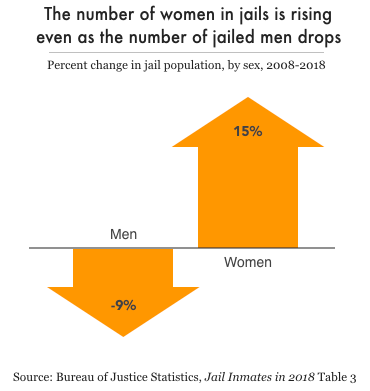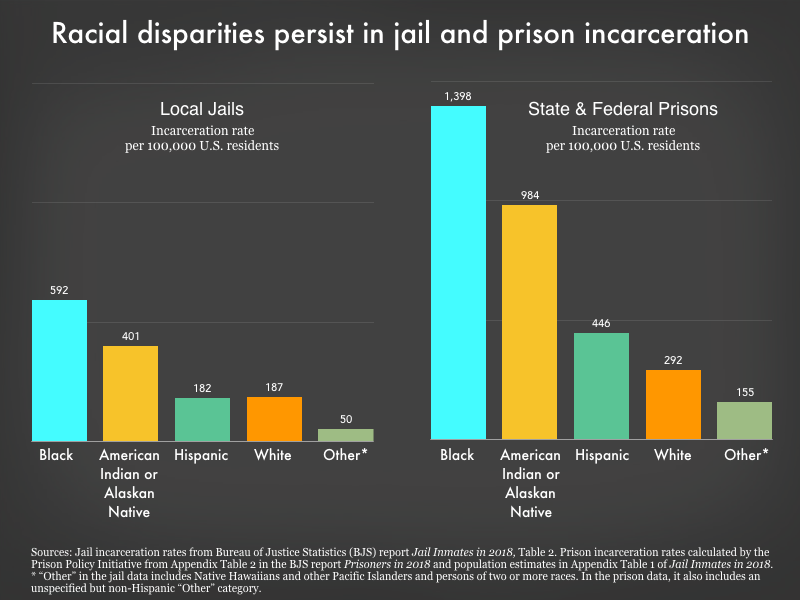Stagnant populations and changing demographics: what the new BJS reports tell us about correctional populations
New BJS reports show that jail and prison populations remain stubbornly high despite decreasing crime rates, and point to the shifting demographics of correctional populations.
by Alexi Jones, May 5, 2020
The COVID-19 crisis is illustrating yet another danger of our overreliance on incarceration, as jails and prisons are rapidly becoming coronavirus hotspots. As correctional facilities around the country grapple with the crisis, two new Bureau of Justice Statistics (BJS) reports, Jail Inmates in 2018 and Prisoners in 2018, provide crucial details about our nation’s correctional populations. The reports highlight the slow pace of decarceration over the past decade, the persistence of pretrial detention despite calls for reform, and the changing demographics of prisons and especially of jails.
Of course, because of COVID-19, jail incarceration in particular has changed dramatically in just a matter of weeks. It remains to be seen whether jail populations will bounce back up after the pandemic subsides, or whether decarceration will become the “new normal” – or at least a more politically acceptable strategy in places that have been reluctant to reduce jail populations. Either way, the pre-pandemic data in the BJS reports are helpful in understanding how we got to the point where so many people are needlessly jailed, and they reveal important demographic shifts in jail populations that merit further action.
Incarceration rates are dropping far too slowly, largely due to pretrial detention
Both of the new BJS reports boast of declining correctional populations, but a closer look at the data reveals the pace of decarceration is still far too slow. Prisoners in 2018 reports that prison populations decreased 9% between 2008 and 2018, meaning prison populations, on average, declined by less than 1% each year. As the nation with the highest incarceration rate in the world, such small declines represent a national failure.
The rate of decarceration in jails is similarly slow, and jail populations have even ticked up in recent years. Although Jail Inmates in 2018 and its press release boast that the “jail incarceration rate decreased 12% from 2008 to 2018,” most of that drop happened over five years ago; the jail population barely budged between 2015 and 2018. There were actually over 18,000 more people in jail on an average day in 2018 than in 2015 – despite the fact that the overall crime rate declined 11% over the same period.
Even worse, the growth of jail populations over those years can largely be attributed to an increase in the number of people held pretrial. The vast majority of people in jails have not been convicted and are simply stuck in jail waiting for their day in court, and their number has increased by 6% since 2015, while the number of people in jail who were convicted declined by 9%. That means pretrial detention has continued to drive all of the net jail growth in recent years, despite the fact that counties around the country are reforming their bail systems to reduce pretrial incarceration. Clearly, these measures have not gone far enough.
Gender, race, and geographic shifts in prison and jail populations
Another key takeaway from the recent reports: There have been striking demographic shifts in jail populations and, to a lesser extent, in prison populations. The number of women incarcerated in jails has increased, and while the women’s prison population is slowly falling, the decarceration of men in prisons continues to outpace that of women. Racial disparities remain persistent, but have actually narrowed in both prisons and jails. Finally, we see that rural jails have grown while urban jail populations have taken more significant steps toward decarceration.
Decarceration efforts seem to impact men’s populations more than women’s

In the ten-year period from 2008 to 2018, the number of women in local jails grew by 15%, while the number of men in jails fell by 9%, mirroring trends seen in many state prison systems and in arrests over the last decade. Our 2018 report found that, since 2009, women’s populations have fared worse than men’s populations in 35 state prison systems. Prisoners in 2018 reveals that the rate of decarceration for men still far outpaces that for women: The male prison population declined 9.3% from 2008 to 2018, but the female population only declined by 3.3%.
While not discussed in these reports, arrest trends may provide some insight into why women’s correctional populations aren’t dropping the way men’s are. Between 2008 and 2018, total arrests declined by 26.5% for men but only declined 13.6% for women. Worse, over these years, which were marked by the opioid crisis, the number of women arrested for drug offenses increased by 34%, while men’s drug arrests fell by almost 8%.
As we explain in Women’s Mass Incarceration: The Whole Pie, it is important to focus on women in local jails, because jails hold almost half of incarcerated women, and they can be especially harmful for women, who suffer from health problems at greater rates than men and more often the caretakers of children. In this light, the growth of women’s jail incarceration is especially troubling.
Racial disparities narrow as jail trends diverge in urban and rural areas
The recent BJS report also reveals that while racial disparities in incarceration persist, they are slowly narrowing. To be clear, Black people are still incarcerated at over 3 times the rate of white people in jails, and more than 5 times the rate of white people in prisons. But the jail incarceration rate for Black Americans is falling while the rate for white Americans is increasing. From 2008 to 2018, the jail incarceration rate for white Americans rose by 12% to 187 per 100,000, the Black incarceration rate fell by 28% to 592 per 100,000, and the Hispanic incarceration rate fell by 34% to 182 per 100,000. Meanwhile, in prisons, the Black incarceration rate declined by 28.2% from 2008 to 2018, while the white incarceration rate declined by 12.8% over the same period.

The changing racial demographics of jails in particular can in part be attributed to the shifting geography of jail incarceration: Jail populations have been shrinking in urban areas, but growing in rural areas, which are disproportionately white. Many urban areas have taken steps to cut their jail populations by reducing pretrial detention, creating alternatives to incarceration, and no longer prosecuting minor drug offenses. Meanwhile, in rural counties, pretrial detention continues to grow, local authorities are increasingly leasing out jail beds to state and federal governments, and there are fewer resources to develop alternatives to incarceration. And of course, rural areas have been devastated by the opioid crisis, and have tended to respond to the crisis with incarceration.
The COVID-19 crisis has drawn unprecedented national attention to the dangers of incarceration. As jails around the country take steps to reduce their jail population, sustained decarceration seems much more possible. As we move forward, these BJS reports show us the work ahead: We must dramatically increase the pace of decarceration, minimize pretrial detention, pay special attention to women’s incarceration and rural jails, and continue to reduce racial disparities.



